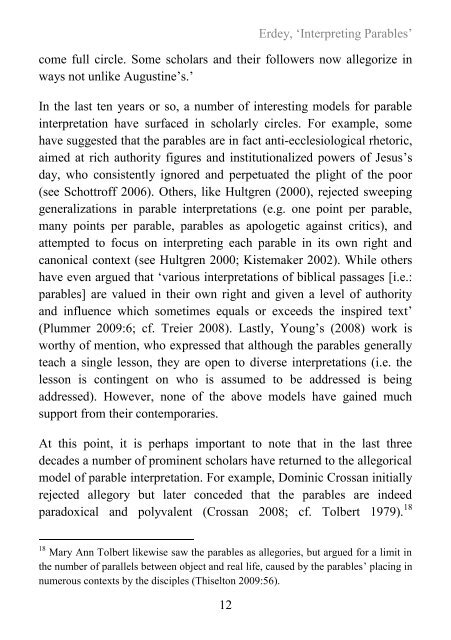Conspectus, vol. 10.pdf - South African Theological Seminary
Conspectus, vol. 10.pdf - South African Theological Seminary
Conspectus, vol. 10.pdf - South African Theological Seminary
You also want an ePaper? Increase the reach of your titles
YUMPU automatically turns print PDFs into web optimized ePapers that Google loves.
Erdey, ‘Interpreting Parables’<br />
come full circle. Some scholars and their followers now allegorize in<br />
ways not unlike Augustine’s.’<br />
In the last ten years or so, a number of interesting models for parable<br />
interpretation have surfaced in scholarly circles. For example, some<br />
have suggested that the parables are in fact anti-ecclesiological rhetoric,<br />
aimed at rich authority figures and institutionalized powers of Jesus’s<br />
day, who consistently ignored and perpetuated the plight of the poor<br />
(see Schottroff 2006). Others, like Hultgren (2000), rejected sweeping<br />
generalizations in parable interpretations (e.g. one point per parable,<br />
many points per parable, parables as apologetic against critics), and<br />
attempted to focus on interpreting each parable in its own right and<br />
canonical context (see Hultgren 2000; Kistemaker 2002). While others<br />
have even argued that ‘various interpretations of biblical passages [i.e.:<br />
parables] are valued in their own right and given a level of authority<br />
and influence which sometimes equals or exceeds the inspired text’<br />
(Plummer 2009:6; cf. Treier 2008). Lastly, Young’s (2008) work is<br />
worthy of mention, who expressed that although the parables generally<br />
teach a single lesson, they are open to diverse interpretations (i.e. the<br />
lesson is contingent on who is assumed to be addressed is being<br />
addressed). However, none of the above models have gained much<br />
support from their contemporaries.<br />
At this point, it is perhaps important to note that in the last three<br />
decades a number of prominent scholars have returned to the allegorical<br />
model of parable interpretation. For example, Dominic Crossan initially<br />
rejected allegory but later conceded that the parables are indeed<br />
paradoxical and polyvalent (Crossan 2008; cf. Tolbert 1979). 18<br />
18 Mary Ann Tolbert likewise saw the parables as allegories, but argued for a limit in<br />
the number of parallels between object and real life, caused by the parables’ placing in<br />
numerous contexts by the disciples (Thiselton 2009:56).<br />
12

















